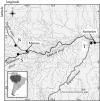Non-flooded riparian Amazon trees are a regionally significant methane source
- PMID: 34865530
- PMCID: PMC8646147
- DOI: 10.1098/rsta.2020.0446
Non-flooded riparian Amazon trees are a regionally significant methane source
Abstract
Inundation-adapted trees were recently established as the dominant egress pathway for soil-produced methane (CH4) in forested wetlands. This raises the possibility that CH4 produced deep within the soil column can vent to the atmosphere via tree roots even when the water table (WT) is below the surface. If correct, this would challenge modelling efforts where inundation often defines the spatial extent of ecosystem CH4 production and emission. Here, we examine CH4 exchange on tree, soil and aquatic surfaces in forest experiencing a dynamic WT at three floodplain locations spanning the Amazon basin at four hydrologically distinct times from April 2017 to January 2018. Tree stem emissions were orders of magnitude larger than from soil or aquatic surface emissions and exhibited a strong relationship to WT depth below the surface (less than 0). We estimate that Amazon riparian floodplain margins with a WT < 0 contribute 2.2-3.6 Tg CH4 yr-1 to the atmosphere in addition to inundated tree emissions of approximately 12.7-21.1 Tg CH4 yr-1. Applying our approach to all tropical wetland broad-leaf trees yields an estimated non-flooded floodplain tree flux of 6.4 Tg CH4 yr-1 which, at 17% of the flooded tropical tree flux of approximately 37.1 Tg CH4 yr-1, demonstrates the importance of these ecosystems in extending the effective CH4 emitting area beyond flooded lands. This article is part of a discussion meeting issue 'Rising methane: is warming feeding warming? (part 2)'.
Keywords: Amazon; floodplain; methane; riparian; soils; trees.
Figures



References
-
- Saunois M, et al. 2020. The global methane budget 2000–2017. Earth Syst. Sci. Data 12, 1561-1623. (10.5194/essd-12-1561-2020) - DOI
-
- Poulter B, et al. 2017. Global wetland contribution to 2000–2012 atmospheric methane growth rate dynamics. Environ. Res. Lett. 12, 094013. (10.1088/1748-9326/aa8391) - DOI
-
- Walter BP, Heimann M. 2000. A process-based, climate-sensitive model to derive methane emissions from natural wetlands: application to five wetland sites, sensitivity to model parameters, and climate. Global Biogeochem. Cycles. 14, 745-765. (10.1029/1999GB001204) - DOI
-
- Melton JR, et al. 2013. Present state of global wetland extent and wetland methane modelling: conclusions from a model inter-comparison project (WETCHIMP). Biogeosciences 10, 753-788. (10.5194/bg-10-753-2013) - DOI
-
- Terazawa K, Ishizuka S, Sakata T, Yamada K, Takahashi M. 2007. Methane emissions from stems of Fraxinus mandshurica var. japonica trees in a floodplain forest. Soil Biol. Biochem. 39, 2689-2692. (10.1016/j.soilbio.2007.05.013) - DOI
MeSH terms
Substances
LinkOut - more resources
Full Text Sources
Miscellaneous

